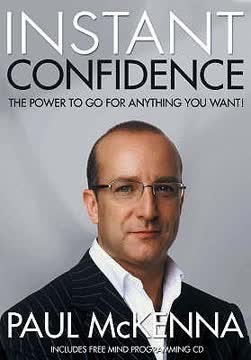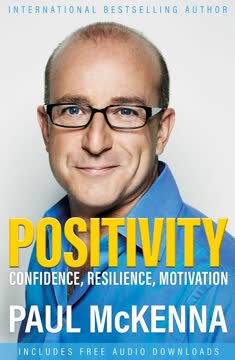Key Takeaways
1. Confidence is a Skill You Develop, Not a Trait You're Born With
This type of confidence is not something that some people are born with and others will never attain—it is the inevitable result of taking a few daily actions on a consistent basis.
Natural confidence. Many believe confidence is an innate quality, but it's actually a learned habit, a "process that you have already begun simply by picking up this book." Even high achievers, from business leaders to Olympic champions, recognize they only tap into a fraction of their potential, with confidence being the crucial differentiator. This system is designed to give you that edge, transforming challenges into insignificant hurdles.
Program your mind. This book, combined with the accompanying hypnosis CD, acts as a personal success coach, systematically boosting your confidence. It's about programming your mind for success, conditioning you to become everything you've ever wanted. Regardless of your past or current skepticism, "it can all change in a day. And that day is today!"
Consistent action. The core principle is simple: "What you practice, you become." Just as athletes train their bodies, you will train your mind. By consistently applying the techniques and listening to the CD, you'll find ease and well-being becoming your natural response to situations that once caused discomfort.
2. Master Your Mind's Internal Dialogue and Imagery
Most people are continually giving themselves suggestions for bad feelings, inaction, and a lack of confidence, and then wonder why they feel so bad!
Internal hypnotist. Your internal voice acts as a powerful hypnotist, constantly giving suggestions to your unconscious mind. If this voice is negative, it limits you, talking you out of action before you even try. It's crucial to replace this critical internal voice with one that supports and cheers you on.
Beyond affirmations. While affirmations are often suggested, their impact is limited if your internal voice contradicts them. The key is to consciously locate your internal voice, imagine it sounding totally confident (louder, clearer, stronger), and then use this new voice to repeat positive, opposite statements to your past negative self-talk.
- "I'm not very confident" becomes "I'm a naturally confident person."
- "I am terrible at giving presentations" becomes "I give excellent presentations."
Visualize success. Your nervous system cannot distinguish between a real and a vividly imagined experience. Just as you recall your front door's color, you can visualize success. Make your mental images:
- Larger
- Brighter
- More colorful
This increases their emotional intensity, programming your mind for positive outcomes.
3. Your Body Language Instantly Transforms Your State
Your mind and body are intimately linked in what is known as a “cybernetic loop.”
Cybernetic loop. The connection between your mind and body is profound; your thoughts affect your physical state, and your physical state affects your thoughts. This means you can deliberately use your body to change your mental and emotional state. Observe how depressed individuals slouch, while champions stand tall and move confidently.
Posture of champions. By consciously adjusting your posture, you send new messages to your brain and the world. Imagine a silver cord gently pulling your spine upright, making you stand taller and more relaxed. Practicing this simple change will reset your muscle memory, making a confident posture your default habit.
One point of power. Centering your attention in your body's core, about an inch below your navel, can instantly make you physically and psychologically stronger. This technique, known in martial arts, allows you to remain calm and stable even under pressure. By focusing your "brain in your tummy," you can reduce stress and feel more grounded, transforming your response to challenging situations.
4. Embrace Your Emotions as Intelligent Guides
Emotions are your unconscious mind’s way of telling you that there is something going on in your life you need to pay closer attention to.
Emotional baseline. Your emotional baseline, set early in life, can be raised through consistent practice of these techniques. While you'll still experience a full range of emotions, your highs will be higher, and your lows will be less severe. Emotions are not random sensations but an important part of your intelligence, signaling what needs attention.
Listen to the message. Suppressing emotions is detrimental; instead, learn to listen to their messages. If changing your self-talk, imagery, and body language doesn't shift an uncomfortable emotion, it likely carries a deeper message from your unconscious mind. Ask yourself, "What do I need to pay attention to here?"
Common emotional messages:
- Anger: A boundary violation, prompting action or acceptance.
- Fear: A warning to prepare for potential danger.
- Frustration: A sign to re-evaluate commitment or strategy for a goal.
- Guilt: A call to correct past actions and avoid repeating them.
- Sadness: Indicates something missing, prompting appreciation for what's lost and what remains, or a fight to reclaim it.
By connecting with your emotions, you gain control and become more emotionally intelligent.
5. Cultivate Unshakeable Self-Belief and Identity
In other words, the way you think about yourself in relationship to the challenges you are currently facing in your life will have a profound impact on your ability to succeed.
Self-fulfilling prophecy. Your beliefs about your capabilities are powerful predictors of success, often more so than past results. If you believe you're unattractive, you'll behave in ways that confirm that belief, creating a self-fulfilling prophecy. Conversely, you can harness this power to build confidence and increase your likelihood of success by focusing on positive beliefs.
Cognitive dissonance. The mind strives for consistency. Holding two conflicting beliefs (cognitive dissonance) is uncomfortable, so the mind will unconsciously change one or both to align. If you resent confident people, your mind will resist you becoming one. This internal conflict can lead to self-sabotage, like driving with one foot on the accelerator and the other on the brake.
Integrated self-belief. To resolve internal conflicts and boost self-belief, identify conflicting parts of yourself (e.g., wanting confidence vs. wanting safety). Ask each part its positive intention, realizing they often seek the same ultimate outcome. Then, imagine a "super part" combining their resources, aligning all parts of yourself towards a common goal, focusing you like a laser beam.
6. Model Success to Accelerate Your Own Growth
Confidence, optimism, security, creativity, persuasiveness, being a great golfer or salesperson are simply skills to be learned and mastered, and any skills that anyone else has mastered you can learn too.
Skills are learnable. Any skill, from confidence to creativity, can be learned and mastered. People who excel do so by running specific sequences of thoughts and behaviors that have become habitual "success programs." This means you can learn from anyone's success.
Two-step process:
- Modeling: Observe and copy how others achieve their results.
- Practice: Repeatedly rehearse the new skill, both mentally and physically, until it becomes automatic.
Just as a child learns to walk by emulating parents, you can accelerate your learning by deliberately modeling successful individuals.
The possibility generator. To model effectively, vividly imagine your role model exhibiting the desired skill. Then, "float into their body," seeing through their eyes, hearing through their ears, and feeling their confidence. Run through this internal experience multiple times, internalizing their physiology and mindset. By adopting their posture, breathing, and expressions, you begin to develop similar thoughts and internal states, transforming your own experience of being alive.
7. Implement a Daily 5-Minute Confidence Workout
It's amazing that taking just a few minutes each day can produce such a profound lasting change in your life.
Conditioning for success. Just as physical exercise is a natural antidepressant, daily mental conditioning can rewire your neurology for happiness and confidence. Studies show that combining physical activity, laughter, and forced positive thoughts can transform clinically depressed individuals into "extreme optimists" in a short time. This program integrates similar elements for rapid change.
The golden rule. "What you practice, you become." The 5-Minute Daily Confidence Workout is designed to interrupt old negative patterns and build new, positive habits. It's a powerful reinforcement for the CD and other techniques, accelerating your journey to natural confidence.
The 5-Minute Daily Confidence Workout:
- Minute One: Success Highlight Films: Visualize past or future successes, making images big, bright, and colorful.
- Minute Two: The Mirror: Look at yourself through the eyes of someone who loves you.
- Minute Three: Compliment Yourself: Use your confident internal voice to give yourself compliments.
- Minute Four: Push the Confidence Switch: Anchor a feeling of intense confidence and apply it to an upcoming situation.
- Minute Five: Confidence in Action: Write down and commit to taking at least one small risk in the next 24 hours.
Consistent practice of this workout will dramatically increase your self-belief and inner comfort.
8. Set Big, Positive, Action-Oriented Goals
Your goals have to be big enough to get you out of bed—to make you feel motivated even before you push the switch.
Power of a goal. Planning and setting goals are fundamental to achieving anything worthwhile. Goals provide direction and ignite passion, making daily actions easier. "You have 50,000 thoughts a day—you might as well make them big ones!"
Focus on what you want. The mind struggles with negatives; telling yourself "don't smoke" often makes you think of smoking. Similarly, focusing on what you don't want in your goals programs your mind for that very outcome. Instead, focus exclusively on what you do want, rehearsing its achievement in your mind.
Four simple steps to success:
- Big enough goals: Create goals that genuinely excite and motivate you.
- Positive focus: Concentrate only on what you desire to achieve.
- Personal control: Ensure your goals are about your actions and feelings, not about changing others.
- Break it down: Divide large goals into small, manageable chunks, so your very next action can be taken within 24 hours.
This approach makes even overwhelming goals achievable, one small step at a time.
9. Develop the Action Habit by Moving Before You're Ready
Truly successful people take action before they feel ready!
Master key to success. The most significant factor in achieving goals is consistent daily action. Just as getting dressed becomes a habit, taking action towards your goals, even small steps, builds unstoppable momentum. By doing at least one thing for each goal every day, you program your nervous system to move in your desired direction.
Wisdom of uncertainty. Many people wait for absolute certainty before acting, but high-achievers develop the habit of taking action before they feel completely ready. This "action habit" responds to the unknown by moving forward, gathering information, and course-correcting as needed. This approach not only leads to success but also increases satisfaction, as the brain rewards new and unexpected experiences with dopamine and serotonin.
Overcoming learned helplessness. Like the zoo bear that continued pacing in a tiny circle even in a vast enclosure, humans can adapt to self-imposed limitations. This "learned helplessness" leads to inaction. The way out is to take action, especially when you don't feel ready. Each step outside your comfort zone rewards your brain with increased confidence and well-being, breaking the cycle of inaction.
10. Cultivate Resilience: Failure is a Stepping Stone
“Failure is an attitude, not an outcome.”
Refuse "no." High achievers like J.K. Rowling, James Dyson, and Kelly Holmes demonstrate resilience by refusing to take "no" for an answer. They persist despite rejections, injuries, or seemingly insurmountable odds. Their determination transforms setbacks into opportunities for growth.
Perception of failure. Most people view failure as a reason to give up, but it's merely a matter of perception. A temporary setback, a missed goal, or a rejection is not true failure unless you stop yourself first. If you can stop smoking for a month, you can stop forever; the "failure" is in the perception that it "didn't work."
Bounce back stronger. High achievers see "failure" as a temporary setback, getting excited about finding new ways to overcome challenges. They ask:
- What's unique about this problem?
- How can I use this to my advantage?
- What do I need to do to succeed?
By reframing negative experiences and taking away their emotional charge, you can learn from them and move forward feeling stronger and more resourceful.
11. Overcome Overwhelm with Targeted Techniques
“Being defeated is often a temporary condition. Giving up makes it permanent.”
Life happens. Despite your best efforts, there will be times when life throws challenges your way, leading to feelings of overwhelm. The most crucial step is self-forgiveness; these moments are an inevitable part of life, not a punishment. The key is to have reliable tools to quickly return to a state of quiet confidence.
Thought Field Therapy (TFT). This innovative technique, developed by Dr. Roger Callahan, involves tapping on specific acupuncture points while focusing on the overwhelming feeling. This process helps to quickly reduce anxiety, stress, or overwhelm by disrupting the "computer program" of the stressful feeling stored in your brain.
The Overwhelm Destroyer technique:
- Rate your stress level (1-10) while focusing on the issue.
- Tap about ten times above one eyebrow.
- Tap under the same eye.
- Tap under your collarbone.
- Tap under your armpit.
- Tap on the "karate chop" point on the side of your hand.
- While continuously tapping the point between your ring and little finger knuckles:
- Close and open your eyes.
- Look down right, center, then down left.
- Rotate eyes 360 degrees clockwise, then counterclockwise.
- Hum "Happy Birthday" aloud.
- Count aloud from 1 to 5.
- Hum "Happy Birthday" aloud again.
- Repeat steps 2-6.
Re-rate your stress. Repeat the sequence until the feeling is gone or significantly reduced. This process, though seemingly strange, is based on hard science and effectively reduces emotional overwhelm.
12. Program Your Unconscious Mind for Automatic Success
“I don’t have any feelings toward my ex now,” “My ex feels like someone I used to know a long time ago,” “Okay, it’s turned off the overwhelming feelings, I can handle it now.”
Compelling future. Designing and taking action on your BIG goals naturally improves your life. However, to achieve "automatic success," you need to program a compelling future into your unconscious mind. This involves understanding your brain's unique way of representing time (your "timeline") and then populating it with vivid images of your desired future.
Creating your future now:
- Imagine your ideal life one year from now, having achieved your BIG goals.
- Create an "ideal scene" representing this future—where you are, who you're with, your successes, and how you feel. Make it big, bright, bold, and colorful.
- Place this image on your mental timeline one year into the future.
- Fill in the blanks: Create progressively smaller pictures of what needs to happen at 3-month intervals leading up to your ideal scene.
This succession of images creates a roadmap, locking in your unconscious mind's direction towards automatic success.
The Threshold Technique. For deeply ingrained negative patterns, like being stuck in a bad situation, the "Threshold Technique" can be transformative. It involves rapidly replaying a series of negative memories associated with the situation, making them bigger, brighter, and more intense until they overlap. This cumulative effect breaks emotional attachments, creating a "threshold" beyond which returning to the old pattern becomes unthinkable. This powerful technique can quickly free you from overwhelming feelings and boost your confidence to move forward.
Last updated:
Review Summary
"I Can Make You Confident" receives generally positive reviews, with readers praising its practical exercises, visualization techniques, and accompanying hypnosis CD. Many report increased confidence and positive life changes after using the book's methods. Some find the content motivating and easy to follow, while others appreciate the mind-body connection emphasis. Critics note the book's reliance on manifestation concepts and dated approach. Overall, readers find value in the quick read and actionable advice, though experiences vary regarding long-term effectiveness.
Similar Books
Download PDF
Download EPUB
.epub digital book format is ideal for reading ebooks on phones, tablets, and e-readers.







![I CAN MAKE YOU RICH (BOOK AND CD) [Hardcover] Summary](https://files.sobrief.com/social/cover_i-can-make-you-rich_360px_1747144112.jpg)







